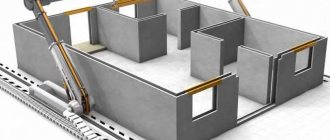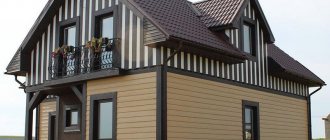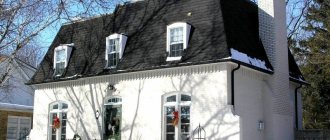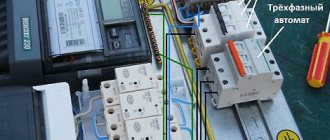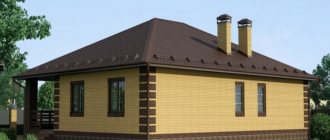Modern water heaters can be used as a reliable source of heating for small individually located residential buildings. A boiler with a high thermal power in the range of 7-12 kW will be quite capable of heating private housing construction up to 100 m2 or a cottage. This heat supply option has its advantages and disadvantages, however, it completely copes with this option.
The positive aspect of a heating boiler is that it can be installed by a home craftsman with his own hands, provided that all individual conditions for such a connection are met. An equally significant argument in favor of such a scheme is the availability of this type of heating at a price and a simple wiring diagram.
Heating via boiler
A water heater is an electric heating device, originally produced for hot water supply. It is made in the form of a container, with an internal arrangement of a thermal electric heating element - heating element. There are designs in which a group of heating elements from 2 to 3 is installed. In order to understand whether such a device is capable of serving as a source of heating for a house, it is necessary to consider the fundamental differences between a heating boiler and an electric boiler.
In the first option, when water is heated, its natural circulation is carried out; for this purpose, appropriate inputs are made. The boiler unit receives cooled return water from heating appliances in the upper part of the structure, and is discharged through the supply pipes from below. The boiler for heating a private house is structurally designed in such a way that both pipes are located on the same side and this does not allow the coolant to move according to the principle of natural circulation. Therefore, it is fundamentally important to connect the heating boiler in such a system using a circulation pump, which will ensure forced movement of water along the circuit.
The most economical electric boiler is a myth
Electricity is much easier to convert into heat than other energy sources - natural gas, solid fuel, diesel fuel. Here are 3 simple examples of heat by-products when using electricity:
- the windings of any operating electric motor always heat up;
- a light bulb (even an LED one) produces heat along with the light;
- Even the wires through which current flows become heated.
Please note that the equipment listed is designed to perform its functions, and not to heat the house. The motor rotates something, the lamp shines, the wiring supplies them with energy. The formation of excess heat is a side effect that occurs due to the resistance of these elements.
Spiral and induction heater converting electricity into heat with 99% efficiency
To convert all electrical energy into thermal energy, it is enough to create a high resistance section in the circuit, which itself will not collapse from heating. This element is called an electric heater. The second (more complex) way to obtain heat is to create Foucault induction eddy currents that heat a metal object in the area of action of the inductor coil.
Important point. Regardless of the conversion method, 98–99% of electricity will turn into heat. That is, any electric heating device operates with an efficiency of 98–99%, no less. This means that the most economical electric boiler does not exist; all units are equally efficient. No matter what home appliance sellers claim.
Specifications
A boiler for heating a private house, which is supposed to be included in the heating circuit, must operate in the temperature range of 60-70 C and have low thermal inertia of the system. The latter characteristic directly depends on the type of heat exchanger and the electrical power of the heating element. In containers up to 250 liters, heating is achieved in 1.5 – 2.5 hours. In addition, such water heating devices must operate from a 220 V household power supply, with a load not exceeding 30 - 40 A, so that a home craftsman can connect the device independently, without requiring special permission from the distribution zone.
Standard structural structure of a domestic water heater:
- A housing that protects functional elements from external interference.
- A storage tank located in the middle of the structure, isolated from it by a heat insulator. The best volume for autonomous heating is considered to be devices from 150 to 300 liters.
- The heating element is a heating element. It can be made in a variety of design forms: rod, spiral and round.
- An essential characteristic for such boilers is thermal power. It should be from 7 to 12 kW, which will allow heating a room up to 120 m2.
- Inlet/outlet pipes on the boiler for heating. The heating performance is determined by the rate of heat transfer, which depends on the diameter of the outlet pipes. In DHW boilers they usually have a cross-section of up to 20 mm, and for the heating function they need at least 32 mm. In this case, the larger the diameter, the more efficient the heating system functions. Of course, provided that the thermal power of the heating element is sufficient.
- Controlling primary temperature sensors of the coolant, integrated into the operation circuit of the circulation pump.
- Relay for monitoring the operation of the electrical network in order to protect the device from possible long-term overloads.
Types of devices
All boilers are divided into 2 main types:
- Flow type. In such a device there is only a small container, and the water is heated “on pass”. This is ensured by equipping boilers with high-power heaters. This type can be used to heat small rooms, but it will require high power consumption and continuous operation of the heater.
- Cumulative type. It is most suitable for heating systems, because... contains a tank in which water is heated. This boiler has a certain inertia, i.e. Heating of the room will begin only when the entire volume of the tank is heated, which will take a certain time. Subsequently, by creating a coolant reserve, you can periodically turn off the electricity supply, which reduces its consumption.
When we talk about boilers, we usually mean electrical devices containing heating elements. However, there is another option when water heating is provided by gas - gas boilers. They are used less frequently, but are quite suitable if there is a centralized gas supply. In this case, you can use the flow-through design of the device.
Keep in mind that the use of gas boilers for home heating requires obtaining special permission from the relevant services and installing a gas flow meter. No permit is required when using electrical household appliances.
Advantages and disadvantages of heating with an electric boiler
The main advantage of the scheme is simplicity. Almost any craftsman can assemble such a structure, since for this purpose neither special qualifications nor complex tools are required. Another advantage is the low price. Most often, electric water heaters for heating are sold at lower prices than electric boilers. Thanks to this, when creating a heat supply system for small objects, you can save significantly. In this case, you can get a very reliable, highly functional system that can be controlled via modern communication lines, for example, Wi-Fi. That is why it integrates well into the Smart Home program.
The disadvantages of using water heaters include:
- Low power.
- The heating element is constantly in working condition, which leads to rapid wear. To guarantee, you need to choose devices with 2 or more heating elements.
Features of the electric boiler
The main design elements of an electric heating boiler are a tank and a heating element. The devices are equipped with monitoring and automatic control systems.
Various models may also include expansion tanks and circulation pumps.
When purchasing a boiler, you should pay attention to the type of electric heating element. Over time, lime particles settle on the heating elements, which affects the power of the device
Electric boilers have several advantages:
- Fire safety . Thanks to automatic control systems and the absence of open flames, the devices are safe. They do not emit toxic substances or combustion products and are not capable of exploding.
- Ease of installation. Electrical equipment requires no flue or ventilation, making installation easy.
- High efficiency . Regardless of the type of heating device, all electric boilers are highly efficient.
- Compactness . Electrical appliances, especially wall-mounted ones, take up little space.
- Nice design . Most modern models are stylistically versatile and look good in the interior.
Electric boilers are almost ideal - easy to use and safe. Their only serious drawback is the high cost of electricity. One more nuance: for residents of regions where there are frequent interruptions in the power grid, it is better to choose boilers that operate from other energy sources, or take care of purchasing additional heating devices.
How does an electric water heater for heating work?
As a rule, such devices are used exclusively for hot water supply. But modern technologies make it possible to use it as an additional thermal circuit for heating water in a heating system. Before using the water heater to prepare the coolant for heating devices, it is necessary to modernize its recharge circuit:
Create a forced coolant circulation circuit.
It is necessary to connect the heating circuit with the installation of protection and control devices: an expansion tank, a circulation pump and shut-off and control valves, a control and protection unit with primary sensors for temperature and pressure of the medium.
The originality of the idea, and its practical implementation, lies in the synchronous operation of the same source: for hot water supply and heating. For this reason, it is recommended to first select an electric pump of the required electrical power. It must be able to cover all hydraulic losses in the system and evenly distribute heat throughout the heating devices. Experts recommend installing water purification filters at the inlet in front of the boiler in simultaneous hot water and heating systems.
Storage tank and heating boiler
The storage tank is ultimately completely identical to a classic water heater. The difference lies in the internal coil, which is connected to the heating system.
A professionally organized heat supply system through a heat exchanger implies that this component will act as a thermal accumulator. The liquid medium in the tank receives heat through a coil heat exchanger connected to the in-house heating pipe system.
Indirect heating boiler
The optimal alternative for heating small rooms is to include an indirect heating boiler in the heat supply scheme. They can be universal, capable of operating on different types of energy carriers: gas, flue gases from the combustion of solid fuels and electricity.
Typically, such devices are installed in heat supply circuits to increase overall efficiency in the form of an additional heating source. The main one is the traditional heating boiler. For efficient operation of an indirect heating water heater, it must be installed before entering return network water into the boiler unit. In this way it is possible to create an optimal heating system.
Calculation of the volume of the storage tank and the power of the heating element
The main element of the boiler, which serves to heat water from the heating system, is volume. It can be calculated using the following formula: V=T*N/(t1-t2), where:
- V—volume;
- T is the time spent heating water;
- N is power measured in kilowatts per hour;
- t1, t2 — thermal regime of the mechanism.
The heating element is a tubular electric heater and the main component of the mechanism. It looks like a spiral wrapped in metal. The system must be filled with dielectric. For example, sand can be used as it. This indicator is subtracted using the following formula: P=0.0011*m*(tk-tн)/T, where
- P—power;
- m is the mass of water to be heated;
- tk is the initial temperature;
- tn — final temperature;
- T is the time spent heating the liquid.
Do-it-yourself electric boiler for the heating system
The price of industrial modifications of heating water heaters is very high - from 12,000 to 70,000 rubles. and higher. Therefore, their alternative can be a heater made in-house. For this case, it is allowed to use an arbitrary steel tank of increased strength, with parameters corresponding to the design ones.
To wire the heating circuits of a homemade water heater, you will need the following parts:
- Tank. It would be preferable to place an order from a specialized organization for a device made of non-corrosive steel or assemble it yourself. It is necessary to place holes on the body in order to solder the inlet/outlet pipes.
- Coil heating element, the best choice is copper. This metal has the best heat transfer coefficient and temperature elasticity.
- Fastening elements for piping heating and hot water systems.
- Automatic safety with primary sensors and protective devices in the form of an air vent and an expansion tank. The kit is purchased in a retail chain according to the parameters of the working tank.
- Thermal protection of the boiler from loss of thermal energy. To do this, a glass wool/basalt heat insulator of at least 5 cm is placed in the layer between the tank and the protective casing.
General positive aspects
Generally speaking, all electric boilers, regardless of type, have a number of advantages:
- ease of execution;
- there is no need to separately create a place for installing equipment;
- no need to think about purchasing, delivering and storing energy;
- there is no need to remove the chimney;
- safety, because there is no possibility of leakage of toxic substances;
- environmental friendliness - no harmful emissions.
If you install electric double-circuit water heating units, connecting all its functions, the consumer will not experience any problems with heating the room or supplying water at the required temperature for household needs.
Installation of a boiler for heating
Installation of a heat supply circuit using a water heater as a heating source is performed as follows:
- Select a location and prepare it for installing the water heater. The site must have a flat horizontal surface measuring at least 1x1 m.
- The foundation for structures with a volume of more than 200 liters is made of concrete, reinforced with reinforcement.
- The water heater structure is installed in a strictly vertical position.
- I am installing an electric circulation pump.
- Perform pipe piping. The outlet of the water heater for heating is connected to the electric pump, and the input is connected to the return line.
- Shut-off and control equipment and security system monitoring sensors are installed.
- The device is connected to the power supply through a separate panel with a machine and an RCD.
- After assembling the circuit, perform hydraulic pressure testing of the heating system and check the functionality of the electrical heating circuit of the heating element.
Boiler for electric heating - service instructions
Servicing electric boilers in heat supply systems is no different from performing the required operations for servicing a heating element device. The heating boiler will work well if you adhere to the following rules:
- Monitor the integrity of the installation’s thermal insulation monthly.
- Observe the temperature difference of the coolant; it should not exceed 15-20 C.
- Monitor the tightness of pipe connections for leaks.
- Every year before the heating season, perform system maintenance by flushing the internal circuit and replacing gaskets.
- They monitor the operating parameters of the electrical network; if there are frequent failures in the electrical lines, you need to install a stabilizer to preserve the electronic control unit.
To select the heating power from the boiler, the calculation is 1 kW per 10 m2 of heated room. This formula is well applicable in systems located in the central climatic region of Russia. Next, you will need to decide on the minimum tank volume. Provided that the minimum level of storage capacity is 5 kW and the temperature difference between forward and return water is -20 C, the volume of the tank will be:
V=5/20=0.25 m3 or 250 l
Heating inertia
The rate of increase in water temperature in pipes for electric boilers is quite high. The average heating time from 25 degrees to 60 degrees is 15-20 minutes, depending on the volume of the system. In this regard, heating using a water heater is significantly inferior to traditional heating. In order for the volume of water in a boiler with a capacity of 150 liters to reach the desired temperature, you need to wait about an hour. The main criteria influencing this indicator are the power of heating elements, the volume of the tank and the entire system as a whole.
However, when the electric boiler stops working, the water in the pipes quickly cools down. At the same time, in a water heater system, a large volume of hot liquid is in the tank and will require several circulation cycles for it to cool. Those. In the event of an unexpected power outage, the coolant in the boiler system will remain hot for some time.
Summarizing these factors, we can determine the main conditions for using an electric water heater for heating:
- The area of the heated room should be relatively small. This is due to the ratio of 1 kW of thermal energy per 10 sq.m.;
- Good quality running water to preserve all heating elements;
- To fill the tank, it is necessary to create the same pressure as in the water supply - 4 atm. This applies only to those cases when a regular boiler is installed that is not intended for heating from a water heater. In specialized models, the minimum pressure value is much lower - from 1.5 atm.
You can use an electric water heater to heat a house with a small area of up to 80 square meters. First of all, this applies to country houses.
The second way to use an instantaneous water heater for heating is to install a heated floor system. But even in this case, you must carefully read the diagram for connecting the device to the pipeline.
Review of water heaters for electric heating
Manufacturers of heating devices already produce conventional boilers, adapted for installation in heat supply networks. Their thermal power has been increased to 12 kW, in addition, they have increased input diameters for connection to the in-house heating system.
Heating from a boiler is not difficult to implement. Since such equipment is widely represented on the market, both domestic and foreign manufacturers. Their choice will depend on the required type of energy carrier and the type of heating: capacitive or indirect heating. The latter are more used in autonomous heat supply schemes, so the principle applies here - the more, the better. They are well used during the heating season, and
In summer, for hot water supply, it is wiser to use combined water heaters.
The most popular models of water heaters that are used in heating systems:
- Heating boiler Thermex Champion Titaniumheat 150 V, made in Russia, heating element, volume 150 l, price - 12,190 rubles.
- Water heater for heating Gorenje TGU150NGB6, made in Serbia, heating element, volume 150 l, price - 14,320 rubles.
- Ariston ABS PRO R 150 V, made in Russia, heating element, volume 150 l, price – 14970 rub.
- Bosch WSTB 200, made in Germany, indirect heating, volume 197 l, price - 40,833 rubles.
- Baxi Premier plus 150 (30 kW), made in Italy, indirect heating, volume 150 l, stainless steel tank price - 68,600 rubles.
- Buderus Logalux SU160/5 made in Germany, indirect heating “coil in coil”, stainless steel DUPLEX, volume 160 l, price - 68869 rub.
Classification
Electric boilers are divided into three main types:
- heating elements;
- electrode;
- induction
In addition, there are a number of other differences between them. For example, there are floor or wall models. They can be connected to 380V or 220V - depending on the size of the room (used for a private house or small apartment). Also the main indicator is the number of circuits in which hot water is located - one or two.
heating elements new
An electric boiler operates based on the process of converting current into thermal energy through the use of tubular heaters installed directly in the tank. The heating element raises the temperature of the liquid inside the pipe. When it enters the heating system, it warms up the room.
To ensure that the device always works as required, a control unit is provided. The heating is controlled by a room temperature controller. It is he who perceives a decrease in this indicator and reports the need to increase heating. The required pressure appears as a result of connecting the pump. Thanks to the use of modern technologies, after the room temperature rises to the set point, the mode is turned off. After some time, the pump that moves the coolant also stops working.
The main advantage of this type of boiler is the absence of contact between the liquid and the heat exchanger. This allows the use of protective devices for automatic shutdown.
The equipment makes it possible to simply implement smooth or step control.
Like any other devices, these have their drawbacks. Heating element boilers have a limited service life compared to other boilers. Premature burnout due to improper use cannot be ruled out. Before purchasing, be sure to pay attention to the possibility of repair or replacement.
Also, scale quickly forms on the tubular heater itself. This significantly reduces the service life of the device. It is imperative to artificially reduce the hardness of the liquid.
Such water heating boilers are single- and double-circuit units. The latter provide hot water supply and heating.
In most cases, installations are hung on the wall, although there are also those that are located on a flat, hard surface.
This type is considered the most popular among electric boilers.
Electrode
Heating of the coolant is carried out by direct passage of current through it. In this case, there are no “intermediaries” in the form of heating elements. Electrolysis does not occur since the anode and cathode are constantly changing places.
It is important to note that if operated without liquid, the electric heating or hot water boiler will not fail. In addition, scale does not destroy the electrodes - sometimes a slight decrease in power is observed.
The coolant temperature increases quickly. This increases the pressure with which water moves through the network - there is no need to install a pump. Perfect for the bathroom as it doesn't take up much space.
We recommend: Pressure testing of the heating system - the most complete information
Such a water unit has an efficiency of about 96%. At the same time, it is durable and reliable in use.
Such a device cannot be connected through a protection element. Only special antifreeze is used as a coolant.
Induction
Such installations have a design similar to a transformer consisting of two circuits. The primary is the magnetic system, and the secondary is the heat exchange device. By means of an alternating field, electricity allows the coolant to be heated.
The main advantages include safety, as well as interaction with various heating fluids. Like the previous option, it is well suited for the bathroom.
But there are also disadvantages. The main ones are the initial price, as well as the cost of subsequent operation.
Boilers
It is worth mentioning electrical storage installations. In fact, they are heating elements equipment installed in parallel. In this case, they can be intended either separately for hot water supply or heating, or for both directions. For the latter, indirect heating systems are used. Such storage electrical installations make it possible to raise the temperature of water for household needs with coolant intended for heating.
This boiler is ideal for use in country houses. It is mainly installed together with boilers that use any energy source. At the same time, it is barely warm on the outside, since usually such installations have high-quality protection that allows energy to be stored inside for a long time.
Photos in the text to illustrate what was said
Storage tank and electric boiler
Installation of an electric boiler in a heating circuit
Boiler Ariston ABS PRO R 150 V
Water heater model Thermex Champion Titaniumheat 150 V
Types of electric boilers for heating systems
Indirect heating boiler
The nuances of choosing the right model
Electricity is an expensive energy resource. If the boiler is selected incorrectly, you will have to pay huge electricity bills.
Therefore, it makes sense to pay attention to some nuances:
- functions . It is necessary to decide what functions the boiler should perform - only heat the house or additionally supply it with hot water.
- Technical parameters of the boiler. Be sure to take into account not only the heated area, but also the degree of its thermal insulation.
- Price . In many ways, the cost of heating devices depends on power, but that’s not all. Additional features can lead to a significant increase in the price of the model. Therefore, you need to clearly understand whether your budget allows you to overpay for convenience.
Even before you start looking for a boiler, you should find out how powerful it should be.
You can calculate the power based on average indicators: 1 kW of electricity is enough to heat a room of 10 square meters. with a ceiling height of up to 3 m. It turns out that a device with a power of 6 kW or more is suitable for heating a small house with an area of 60 m2.
When purchasing an electric boiler, energy consumption is of fundamental importance. It’s better to overpay for a more expensive model, but save on its operation
It is advisable to take into account the degree of thermal insulation and buy a boiler with a small power reserve (20%). If the house is poorly insulated, it is better to choose a gas or solid fuel model, since heating with electricity will be too expensive.
Types of double-circuit boilers
There are a considerable number of options for boilers with two circuits. We have divided them into segments and will describe each in detail.
By heating method
- Flow-through. Such models are very popular. They are very powerful and allow hot water to flow into the faucet quickly. In such boilers, either two separate heat exchangers are used (one is used to heat the coolant, and the other is used to transfer heat from the heated coolant of the heating system to the hot water supply circuit), or one bithermic (one heat exchanger heats the coolant of the heating system and hot water).
- With built-in tank. Less common. With this design, the water is first heated in a separate tank and only then enters the mixer. Often, such boiler models are purchased quite rarely. Many people prefer to install a separate boiler and indirect heating tank. But such boiler options are quite possible. As an example, you can look at the Baxi Luna 3 Combi boiler.
By installation method
- Wall-mounted. They are extremely convenient, as they can be installed in any room, be it a corridor or a kitchen. At a fairly low price, these models have good performance. On average, they can provide heat to rooms up to 350 square meters in size. Such models are readily installed both in private houses and in apartments.
- Floor-standing. These boilers are more expensive, but they have high power and are capable of heating a huge cottage with several floors. They take up a lot of space, require a separate room and special care. Often, high-power boilers are all single-circuit, which initially means using a separate tank that will be heated by the boiler.
By method of removing liquid
- With open camera. The chamber receives oxygen from the living space. This is not always possible. The disadvantage of this solution is often the lower efficiency of the boiler. Especially if the chimney is mounted “from the bulldozer”.
- With a closed camera. Air from outside is used. They have high power and excellent tightness. They do not require a full chimney. They are usually equipped with a meter-long coaxial pipe, which is sufficient for normal operation of the boiler.
Manufacturers rating
For those people who do not pay too much attention to price, but want to buy a functional model from trusted manufacturers, I have prepared a rating of the most famous brands.
- Stiebel Eltron is a German company. The equipment of this brand is not cheap, but it is always quality, accompanied by a 3-year warranty. Devices from the Germans are distinguished by ease of connection and use and wide functionality.
- AEG is a German company with good quality. The brand has different product lines with a flexible pricing policy, but even the most inexpensive models are rarely included in the service. This makes them popular on the Russian market.
- Electrolux. The company is from Sweden, but the assembly is predominantly Chinese. Due to this and cheaper materials, the brand sells equipment similar to German companies, but with a cheaper price tag. The quality is at a decent level.
- Atmor. The equipment of the Israeli company is more common than the equipment of the brands mentioned above. Advantages - high quality, precise operation of automation, small size, low prices. Atmor equipment rarely offers a wide range of functions, but for those who need a budget option for a summer house or apartment, it is perfect.
- Timberk. Another Swedish brand. Among the features are low price, compactness, high-quality assembly and bright design.
Before purchasing, you should decide on the power and understand what functions are really needed in a particular case. Sometimes you will have to overpay for additional, but unnecessary options, and there won’t be much point in it.
Solenoid valve for DHW system with water recirculation
Solenoid valve UNIPUMP BCX-20 3/4″ (normally closed)
Operating medium temperature range – 0…+120 ºС Operating pressure – 0.5…16 bar Power supply parameters – ~220 ±10% V, 50 Hz Protection degree – IP65 Normal closed 20 – DN (nominal diameter) in mm
A normally closed valve opens the way for liquid flow when voltage of ~220 V enters the valve coil (solenoid).
